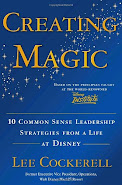What a fantastic guest blogger I have today. Brian Tracy has been a huge influence to so
many people in achieving personal and business goals. His 3rd edition (out this week) of Eat That Frog is just one part of that mold. Here's a great book that's going to help you to stop that procrastinating. Admit it. We all do it. With Brian's book, with 2 new chapters, you'll learn that you don't need to do everything to be successful and that in trying to you lose focus and begin to drop the ball. Share this book with your entire team.
Plan Every Day in Advance
By Brian Tracy
The following post is an excerpt from chapter 2 of Eat That Frog.
A word about frogs… It has been said that if the first thing you do each morning is to eat a live frog, you can go through the day with the satisfaction of knowing that that is probably the worst thing that is going to happen to you all day long. Your “frog” is your biggest, most important task, the one you are most likely to procrastinate on if you don’t do something about it. It is also the one task that can have the greatest positive impact on your life and results at the moment.
Plan Every Day in Advance
You have heard the old question, “How do you eat an elephant?” The answer is “One bite at a time!”
How do you eat your biggest, ugliest frog? The same way: you break it down into specific step-by-step activities and then you start on the first one.
Your mind, your ability to think, plan, and decide, is your most powerful tool for overcoming procrastination and increasing your productivity. Your ability to set goals, make plans, and take action on them determines the course of your life. The very act of thinking and planning unlocks your mental powers, triggers your creativity, and increases your mental and physical energies.
Conversely, as Alec Mackenzie wrote, “Taking action without thinking things through is a prime source of problems.”
Your ability to make good plans before you act is a measure of your overall competence. The better the plan you have, the easier it is for you to overcome procrastination, to get started, to eat your frog, and then to keep going.
One of your top goals at work should be to get the highest possible return on your investment of your mental, emotional, and physical energy. The good news is that every minute spent in planning saves as many as ten minutes in execution. It takes only about 10 to 12 minutes for you to plan your day, but this small investment of time will save you up to two hours (100 to 120 minutes) in wasted time and diffuse effort throughout the day.
You may have heard of the Six-P Formula. It says, “Proper Prior Planning Prevents Poor Performance.”
When you consider how helpful planning can be in increasing your productivity and performance, it is amazing how few people practice it every single day. And planning is really quite simple to do. All you need is a piece of paper and a pen. The most sophisticated Outlook system, computer app, or time planner is based on the same principle. It is based on your sitting down and making a list of everything you have to do before you begin.
One of the most important rules of personal effectiveness is the 10/90 Rule. This rule says that the first 10 percent of time that you spend planning and organizing your work before you begin will save you as much as 90 percent of the time in getting the job done once you get started. You only have to try this rule once to prove it to yourself.
When you plan each day in advance, you will find it much easier to get going and to keep going. The work will go faster and smoother than ever before. You will feel more powerful and competent. You will get more done faster than you thought possible. Eventually, you will become unstoppable.
Brian Tracy is one of the top business speakers in the world today. He has designed and presented seminars for more than 1,000 large companies and more than 10,000 small and medium- sized enterprises in 75 countries on the subjects of Leadership, Management, Professional Selling, Business Model Reinvention, and Profit Improvement. He has addressed more than 5,000,000 people in more than 5,000 talks and presentations worldwide. He currently speaks to 250,000 people per year. His fast-moving, entertaining video-based training programs are taught in 38 countries.
In addition to Eat That Frog, Brian has written more than 80 books that have been translated into 42 languages, including Kiss That Frog!, Find Your Balance Point, Goals!, Flight Plan, Maximum Achievement, No Excuses!, Advanced Selling Strategies, and How the Best Leaders Lead. He is happily married, with four children and five grandchildren. He is the president of Brian Tracy International and lives in Solana Beach, California. He can be reached at briantracy@briantracy.com.






